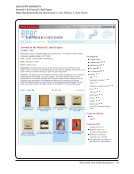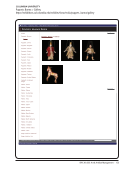SPEC Kit 333: Art &Artifact Management · 49
Challenge 1 Challenge 2 Challenge 3
Poor physical control (storage options not
ideal).
Sporadic intellectual control (some parts
well constrained, others not at all).
Preservation and conservation are
particularly challenging, given the
breadth of materials in the collection
and limited lab facilities for specialized
processes.
Developing adequate descriptive
cataloging standards for the variety of
materials in the collection.
Storage space, particularly for physical
objects with different storage and
shelving requirements.
Preservation and storage of unusual
material.
Making sound acquisition decisions for
media unfamiliar to our professionals.
Ensuring monetary appraisal is carried
out appropriately.
Preservation issues. Storage issues. Access issues.
Preservation of various formats,
especially things like architectural
drawings!
Size: we have *millions* of historic
photographs.
Digitization pressures: item-level versus
collection-level access and attendant
staffing resources!
Proper housing. Access.
Proper storage. Curator does not have formal education/
training in management of art objects/
artifacts so therefore unprepared to
describe materials as effectively as
someone with, say, museum training.
Proper storage and preservation: art and
artifacts do not generally fit standard
library and archival shelving.
Use by researchers: reading room space
not geared for these genres of material.
Proper storage conditions. Proper housings. Limiting any physical damage when used
in exhibitions or by researchers.
Proper storage for preservation: Oversize
items, such as posters and prints often
require specialized storage. 3D objects,
including historic military uniforms and
clothing, also require storage and care
that can present challenges in an archival
setting.
Level of description: User access to art
and artifacts can often benefit from
item-level description, possibly with
the addition of digital photographs or
surrogates. We rarely have staff time
available to produce description at this
level and often rely on traditional archival
collection or fonds-level description,
possibly with a folder or basic item
list. Instances of detailed item level
description are more rare.
Proper storage. Access to, and reproduction of, oversized
and/or fragile items.
Identification of works and description of
unidentified pieces.
Resources: i.e., more professional,
support, and student staff.
More time to work on materials. Appraisal: some items/collections do
not belong and should not stay with the
repository.
Challenge 1 Challenge 2 Challenge 3
Poor physical control (storage options not
ideal).
Sporadic intellectual control (some parts
well constrained, others not at all).
Preservation and conservation are
particularly challenging, given the
breadth of materials in the collection
and limited lab facilities for specialized
processes.
Developing adequate descriptive
cataloging standards for the variety of
materials in the collection.
Storage space, particularly for physical
objects with different storage and
shelving requirements.
Preservation and storage of unusual
material.
Making sound acquisition decisions for
media unfamiliar to our professionals.
Ensuring monetary appraisal is carried
out appropriately.
Preservation issues. Storage issues. Access issues.
Preservation of various formats,
especially things like architectural
drawings!
Size: we have *millions* of historic
photographs.
Digitization pressures: item-level versus
collection-level access and attendant
staffing resources!
Proper housing. Access.
Proper storage. Curator does not have formal education/
training in management of art objects/
artifacts so therefore unprepared to
describe materials as effectively as
someone with, say, museum training.
Proper storage and preservation: art and
artifacts do not generally fit standard
library and archival shelving.
Use by researchers: reading room space
not geared for these genres of material.
Proper storage conditions. Proper housings. Limiting any physical damage when used
in exhibitions or by researchers.
Proper storage for preservation: Oversize
items, such as posters and prints often
require specialized storage. 3D objects,
including historic military uniforms and
clothing, also require storage and care
that can present challenges in an archival
setting.
Level of description: User access to art
and artifacts can often benefit from
item-level description, possibly with
the addition of digital photographs or
surrogates. We rarely have staff time
available to produce description at this
level and often rely on traditional archival
collection or fonds-level description,
possibly with a folder or basic item
list. Instances of detailed item level
description are more rare.
Proper storage. Access to, and reproduction of, oversized
and/or fragile items.
Identification of works and description of
unidentified pieces.
Resources: i.e., more professional,
support, and student staff.
More time to work on materials. Appraisal: some items/collections do
not belong and should not stay with the
repository.


















































































































































































